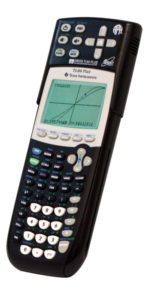Graphing calculators are often a necessity in secondary and higher education classrooms. For individuals who are visually impaired, standard ones are wholly inaccessible. The Orion TI-84 Plus Talking Graphing Calculator is the world’s first fully accessible handheld graphing calculator.
The Orion TI-84 Plus Talking Graphing Calculator includes the same functions as the TI-84 Plus. However, in addition to the standard functions, it also includes a compact accessory that snaps to the top of the TI-84 Plus. This accessory enables individuals with vision impairments to fully interact with the calculator. With the Talking Graphing Calculator accessory attached, users will experience:
- High-quality, synthesized voice which announces each key and the answer on the display
- Haptic feedback
These unique SonoGraph™ audio and haptic features provide users with multi-modal feedback. With this, users are able to review the contents of the screen at any time, including all text and graphical information, without affection the calculation. “The Orion TI-84 Plus Talking Graphing Calculator is fully expandable with hardware accessories through a USB-port and can also print or emboss graphs when connected to a printer or embosser.”
Orion TI-84 Plus Talking Graphing Calculator’s Features:
- Easy for teachers to help with
- LCD display and keypad are identical to standard TI-84 Plus
- Unique Learning Mode for instantaneous key identification without interrupting operation
- Calculator functions have the benefit of decades of experience from TI
- Full access to all menus, expressions, text, and symbols displayed on screen
- Use the screen reader to review the screen without losing your place
- Large list of scientific, statistical, and financial functions
- “Superb synthesized speech (FonixTalk from SpeechFX) with choice of voices, speech rates, and pitch.”
Click here to learn more or order the Orion TI-84 Plus Talking Graphing Calculator.


Calculator, machine for automatically performing arithmetical operations and
certain mathematical functions. Modern calculators are descendants of a digital
arithmetic machine devised by Blaise Pascal in 1642. Later in the 17th century,
Gottfried Wilhelm Leibniz created a more-advanced machine, and, especially in the
late 19th century, inventors produced calculating machines that were smaller and
smaller and less and less laborious to use. In the early decades of the 20th century,
desktop adding machines and other calculating devices were developed. Some were key-driven,
others required a rotating drum to enter sums punched into a keyboard, and later the drum was spun by electric motor.